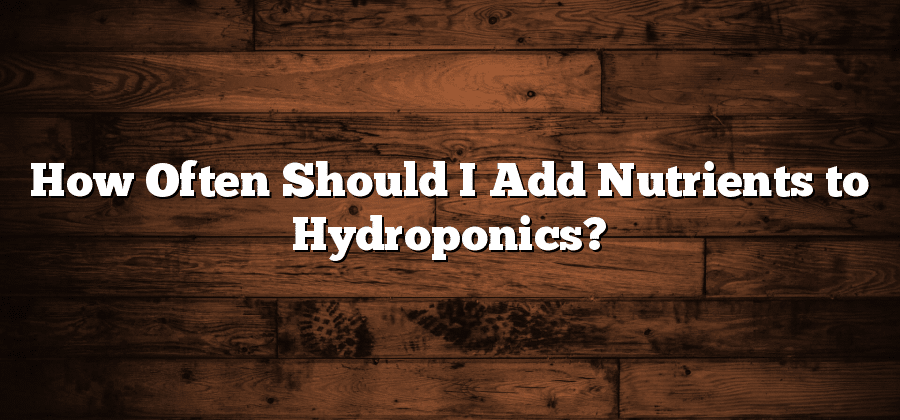Nutrient Requirements for Hydroponics Systems
In hydroponics systems, understanding the nutrient requirements of plants is crucial for successful cultivation. Unlike traditional soil-based farming, hydroponics relies on a nutrient-rich solution to provide essential elements for plant growth. These nutrients are dissolved in water and delivered directly to the plant’s root system, allowing for efficient absorption and utilization.
The nutrient requirements for hydroponics systems vary depending on the specific crop being grown. However, there are some essential elements that are universally required by all plants. These include macronutrients such as nitrogen, phosphorus, and potassium, as well as micronutrients like iron, manganese, and zinc. Balancing these nutrients in the hydroponic solution is essential to promote healthy plant growth and maximize yield. Regular monitoring of nutrient levels and adjusting the solution accordingly is necessary to ensure that plants receive the optimal amount of nutrients they need to thrive.
Understanding Plant Nutrient Uptake in Hydroponics
Plant nutrient uptake in hydroponics is a complex process that requires a thorough understanding of the nutrient requirements of different plant species. In a hydroponic system, plants obtain their essential nutrients directly from the nutrient solution, as there is no soil present. This means that the grower has complete control over the nutrient composition and concentration, allowing for optimal plant growth and development.
The process of nutrient uptake in hydroponics involves several factors. Firstly, the availability of nutrients in the solution plays a crucial role. The plant roots must be in close proximity to the nutrients for efficient absorption. This is why it is important to ensure that the nutrient solution is properly mixed and evenly distributed throughout the system. Secondly, the pH of the nutrient solution also affects nutrient uptake. Each nutrient has an optimal pH range for efficient absorption, and any deviation from this range can hinder uptake. Therefore, it is crucial to regularly monitor and adjust the pH of the nutrient solution in hydroponics systems to ensure optimal nutrient uptake for the plants.
Factors Affecting Nutrient Uptake in Hydroponics
Factors affecting nutrient uptake in hydroponics are crucial to understand for successful plant growth and development. One important factor is the pH level of the nutrient solution. Different plant species have different pH preferences, and it is essential to adjust the pH of the solution accordingly. Most plants prefer slightly acidic conditions, with a pH range of 5.5 to 6.5. However, some plants, like blueberries, prefer more acidic conditions, while others, like lettuce, can tolerate slightly alkaline conditions.
Another factor that affects nutrient uptake is the concentration of nutrients in the solution. Plants require a balanced and optimal supply of nutrients to thrive. Having too high or too low nutrient concentrations can negatively impact plant growth and development. It is crucial to monitor nutrient levels regularly and adjust them as needed to ensure that plants receive the appropriate amount of nutrients. Additionally, the water quality used in hydroponic systems can also affect nutrient uptake. High levels of contaminants, such as chlorine or heavy metals, can hinder plant nutrient absorption. Therefore, it is advisable to use purified water or treat the water appropriately before using it in hydroponic systems.
Monitoring Plant Nutrient Levels in Hydroponics
Monitoring the nutrient levels in a hydroponics system is vital for the successful growth of plants. Unlike traditional soil-based methods, hydroponics relies on a precise balance of nutrients in the water solution to provide plants with the essential elements they need to flourish. By regularly measuring and adjusting these nutrient levels, growers can ensure that plants are getting the right amount of nutrients at the right time, resulting in healthier and more productive crops.
There are several ways to monitor nutrient levels in a hydroponics system. One common method involves using an electronic pH meter to measure the acidity or alkalinity of the water. This is important because the pH of the nutrient solution directly affects how effectively plants can absorb nutrients. Additionally, electrical conductivity (EC) meters can be used to measure the concentration of nutrients in the water. This provides growers with valuable information about the strength of their nutrient solution, allowing them to make necessary adjustments to maintain optimal levels for plant growth.
Determining the Ideal Nutrient Schedule for Hydroponics
One of the key factors in successfully growing plants in a hydroponics system is determining the ideal nutrient schedule. This involves understanding the specific nutrient requirements of the plants being grown and ensuring that they are provided with the necessary elements in the right proportions and at the right times.
To determine the ideal nutrient schedule for hydroponics, growers need to consider a variety of factors. Firstly, the growth stage of the plants must be taken into account, as their nutrient requirements can vary significantly during different phases of growth. Additionally, factors such as plant species, nutrient uptake rates, and environmental conditions, including temperature and lighting, need to be considered. Balancing these variables is crucial in order to maintain optimal plant health and maximize growth and productivity in hydroponics systems.






